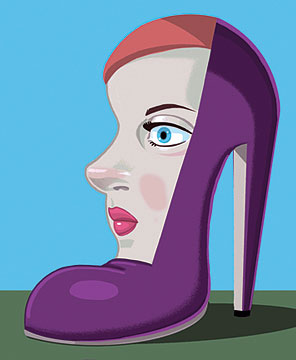When I was a student at Brown, I did not care about shoes. My friends and I were oblivious to fashion trends, except when it came to critical and feminist theory. We knew Adorno instead of adornment, de Beauvoir rather than de la Renta, the "epistemology of the closet" instead of shopping for our closets.

But here I am at age forty-one, a shoe maven. I recently completed a book, Bad Shoes & The Women Who Love Them, about our national shoe obsession. I regularly dispense advice to women about their shoes. I write and give talks around the country on the history of obscenely high platforms (they go back more than 500 years), on women who lie when they claim their five-inch wedges are comfortable, and on what Freud had to say about women's shoes and sex.
After Brown, I wrote several books on topics about as far away from shoes as you can get. Slut!, Catfight, and Taking Back God are all about double standards and other forms of gender discrimination. But when I began lecturing on the public circuit, I worried it might be easy to dismiss feminist ideas when the messenger looked careless about her appearance. I started getting dressed up and wearing makeup. I bought and wore shoes of varying heights, styles, and colors. Slingbacks. Mules. Peep-toe platforms. It was death to Docs, hello to heels.
Several years ago, my feet started to hurt. It got bad enough that I visited a podiatrist, who told me I had bunions. My shoes did not cause my bunions—instead, I can thank my genes—but they exacerbated the problem. From that moment on, I was to wear only shoes with arch support. Before hitting my forties, I found myself cruising the grandma aisle at the shoe store, so I researched my options. I discovered that I'd been choosing "bad" shoes. Wearing a high-heeled, narrow shoe on a regular basis leads to foot deformities, which are both painful and ugly.
Now it's hard to get me to stop talking about shoes. I don't tell women to get rid of their heels; I love heels too. I just tell them to wear them sparingly. There are many beautiful shoes on the market that do not martyr the feet.
Everyone who knew me at Brown finds my new commitment to shoe-sense hilarious. But in fact, feet are a feminist issue. Many women routinely wear "bad" shoes in the name of fashion. Some women are so concerned about appearing feminine that even when they're in agonizing pain they refuse to ditch their ill-fitting stilettos. In some extreme cases, women go under the knife for cosmetic foot surgery. Instead of changing their shoes to fit their feet, they change their feet to fit their shoes. This horrifying trend is not altogether different from the practice of foot binding.
Readers, I beseech you to wear "good" shoes. You need to take care of your feet. Better you should know Steinem than stilettos, Lacan than Louboutin.
Leora Tanenbaum (www.leoratanenbaum.com) lives and works in New York City.
Illustration by Alison Seiffer





